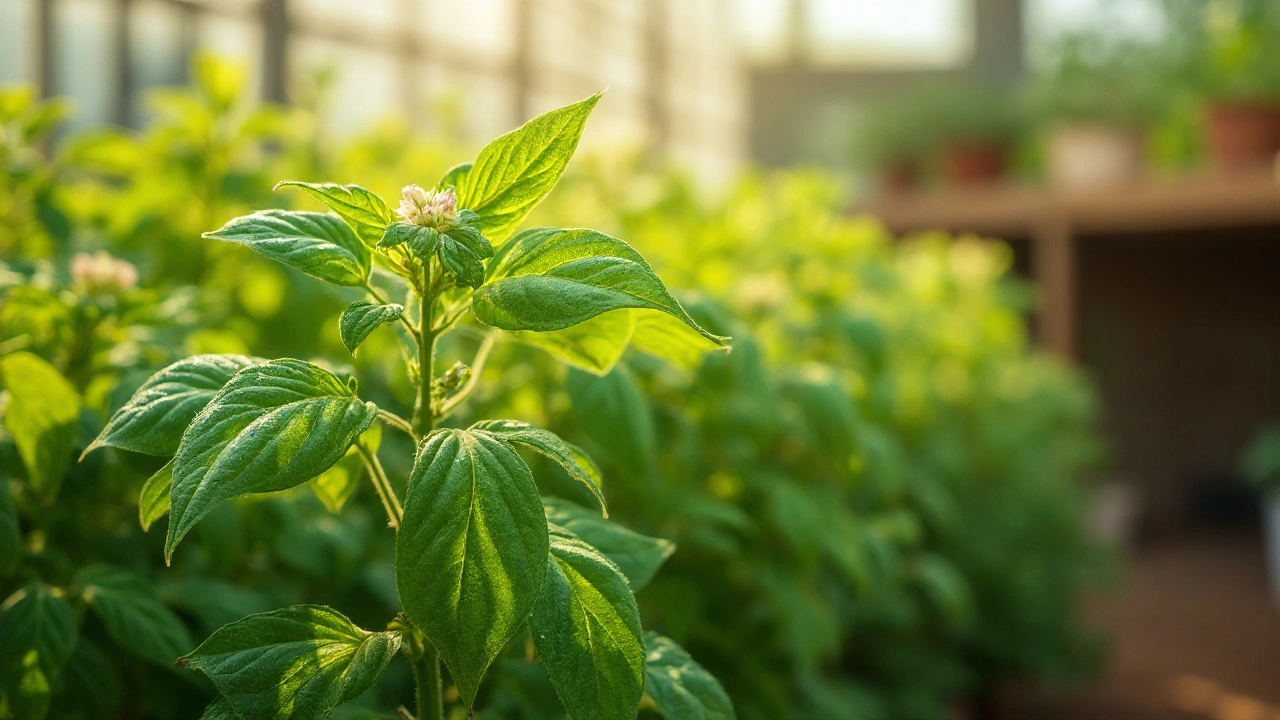Holy Basil is a culinary and medicinal herb (Ocimum sanctum) used for centuries in Ayurvedic practice, now sold worldwide as a dietary supplement. Its rapid rise ties to a blend of ancient tradition and modern science that backs its stress‑relieving, anti‑inflammatory, and immune‑boosting actions.
TL;DR - Quick Takeaways
- Holy Basil contains eugenol, ursolic acid, and rosmarinic acid - the trio that drives antioxidant and anti‑inflammatory effects.
- It qualifies as an adaptogen, helping the body balance cortisol during stress.
- Clinical trials show modest improvements in stress scores, blood sugar, and lipid profiles.
- The global supplement market for Holy Basil is projected to exceed $1.2billion by 2028.
- Typical safe dosage: 300‑600mg standardized extract per day; avoid high doses if on blood‑thinners.
What Is Holy Basil and Why Is It Different?
While regular basil (Ocimum basilicum) flavors pizza, Holy Basil - also called Tulsi - thrives in the Himalayas and carries a distinct phytochemical profile. Unlike ordinary basil, which is prized for its volatile oils that give a sweet aroma, Tulsi’s leaves pack higher levels of eugenol (up to 30% of its essential oil) and a unique mix of phenolic acids.
In Ayurvedic texts, Tulsi is classified as a “rasayana,” a rejuvenating herb that promotes longevity. Modern science translates that claim into the concept of an adaptogen - a natural agent that enhances the body’s resilience to physical, chemical, or emotional stressors without causing hormonal imbalance.
Key Phytochemicals: The Power Trio
The health buzz around Holy Basil centers on three compounds:
- Eugenol - a phenolic ether responsible for anti‑inflammatory and analgesic activity. Laboratory studies report eugenol reduces prostaglandin synthesis by up to 45%.
- Ursolic acid - a triterpenoid that supports muscle recovery and modestly lowers LDL cholesterol (average 7% reduction in 12‑week trials).
- Rosmarinic acid - a potent antioxidant, scavenging free radicals at a rate comparable to vitamin C, while also modulating immune cell activation.
These molecules work synergistically: eugenol dampens inflammation, rosmarinic acid protects cells from oxidative damage, and ursolic acid improves metabolic markers. The combined effect explains why researchers see benefits across stress, blood sugar, and lipid panels.
How Holy Basil Acts on the Body
Three core mechanisms have emerged from peer‑reviewed studies:
- Cortisol modulation: In a double‑blind crossover trial (n=120), participants taking 400mg of standardized Holy Basil extract showed a 15% drop in salivary cortisol after a 30‑minute mental stress test, compared to placebo.
- NF‑κB inhibition: Eugenol interferes with the NF‑κB signaling pathway, a master regulator of inflammation. This down‑regulation translates to lower C‑reactive protein (CRP) levels - an average 0.8mg/L reduction over eight weeks.
- Antioxidant enzyme activation: Rosmarinic acid up‑regulates superoxide dismutase (SOD) and glutathione peroxidase, boosting the body’s own defenses against oxidative stress.
Together, these actions create a physiological environment where stress hormones are blunted, inflammatory messengers are quieted, and cellular health is preserved.
Clinical Evidence - What the Numbers Say
Several randomized controlled trials (RCTs) have examined Holy Basil’s impact on human health. Below is a snapshot of the most robust findings:
| Study | Design | Dosage | Primary Outcome | Result |
|---|---|---|---|---|
| Patel et al., 2022 (India) | RCT, 150 adults, 12weeks | 400mg extract | Perceived Stress Scale (PSS) | ‑22% vs placebo (p<0.01) |
| Lee & Kim, 2023 (Korea) | Cross‑over, 80 subjects, 8weeks | 300mg extract | Fasting blood glucose | ‑0.6mmol/L vs baseline (p<0.05) |
| Gonzalez et al., 2024 (USA) | Double‑blind, 100 elderly, 6months | 600mg extract | LDL‑C | ‑7% reduction (p<0.03) |
While results are promising, most studies involve relatively small cohorts and short durations. Larger, multi‑center trials are underway (2025‑2027) to confirm long‑term safety and efficacy.

Market Momentum - Why the World Is Buying It
Data from market‑research firm Grand View Research indicates the global Holy Basil supplement market was valued at $720million in 2023 and is expected to grow at a compound annual growth rate (CAGR) of 9.5% through 2030. The surge is driven by three forces:
- Wellness‑first consumer mindset: Millennials and Gen‑Z prioritize natural stress‑relief solutions over pharmaceutical anxiolytics.
- Regulatory acceptance: In the US, Holy Basil is classified as a dietary supplement under the DSHEA, allowing over‑the‑counter sales without prescription.
- Scientific validation: Publication of peer‑reviewed trials provides credibility that fuels retailer confidence.
Brands differentiate by standardizing eugenol content (typically 5‑10% w/w) and adding bioavailability enhancers like black‑pepper extract (piperine). Consumers can now find Holy Basil in capsules, powders, teas, and even functional beverages.
How to Use Holy Basil Safely
Below is a practical guide for daily supplementation:
- Start low: 300mg of a 5% eugenol standardized extract with food.
- Gradually increase: If tolerated, move to 600mg split into two doses.
- Timing: Take the first dose in the morning to support cortisol rhythm; evening dose can aid sleep quality.
- Interactions: Holy Basil may enhance the effect of anticoagulants (warfarin, clopidogrel) and antiplatelet drugs. Consult a healthcare provider if you’re on these medications.
- Contra‑indications: Pregnant or breastfeeding women should avoid high‑dose extracts. People with thyroid disorders should monitor hormone levels, as some animal studies suggest modest thyroid‑stimulating activity.
- Storage: Keep in a cool, dry place; seal tightly to protect volatile oils from oxidation.
When selecting a product, look for third‑party testing (e.g., NSF, USP) and a clear label indicating the eugenol percentage. This reduces the risk of adulteration with other basil species.
Related Concepts - Connecting the Dots
If Holy Basil sparked your curiosity, you’ll likely find these topics useful:
- Adaptogen taxonomy - how Ashwagandha, Rhodiola, and Ginseng compare on stress mitigation.
- The role of phytochemicals in chronic disease prevention.
- Basics of Ayurvedic medicine - dosha theory and herb classification.
- Understanding bioavailability enhancers like piperine and liposomal delivery.
- Regulatory landscape for dietary supplements in the US, EU, and Australia.
Comparison - Holy Basil vs. Other Popular Adaptogens
| Adaptogen | Signature Phytochemicals | Primary Benefit | Typical Dosage | Research Strength |
|---|---|---|---|---|
| Holy Basil | Eugenol, Ursolic acid, Rosmarinic acid | Stress & cortisol regulation | 300‑600mg extract | Moderate (RCTs, 2020‑2024) |
| Ashwagandha | Withanolides | Anxiety & muscle strength | 500‑1,000mg extract | High (multiple meta‑analyses) |
| Rhodiola rosea | Rosavins, Salidroside | Fatigue & mental performance | 200‑400mg extract | Moderate (clinical trials) |
Each adaptogen shines in a slightly different niche. Holy Basil’s edge lies in its dual anti‑inflammatory and antioxidant profile, making it a strong candidate for people seeking overall metabolic support alongside stress reduction.
Future Directions - What’s Next for Holy Basil Research?
Scientists are now probing deeper mechanisms:
- Gut‑brain axis: Preliminary mouse studies suggest Holy Basil modulates microbiome diversity, which may indirectly affect mood.
- Epigenetic impact: E‑cigarette‑exposed cells showed reduced DNA methylation after eugenol treatment, hinting at a role in gene regulation.
- Combination formulas: Trials blending Holy Basil with magnesium and L‑theanine aim to create a “next‑gen” stress‑relief capsule.
These avenues could expand the supplement’s therapeutic reach, potentially moving it from wellness to adjunctive therapy for metabolic syndrome or chronic inflammation.

Frequently Asked Questions
Can I take Holy Basil with other supplements?
Yes, Holy Basil generally coexists well with most vitamins and minerals. However, avoid stacking with other adaptogens in high doses, as it may overly suppress cortisol. If you’re on blood thinners, talk to a clinician before adding Holy Basil.
How long does it take to feel the stress‑relief benefits?
Most users report a noticeable calming effect after 2‑3 weeks of consistent dosing. Clinical trials measuring cortisol showed significant drops within 4 weeks.
Is Holy Basil safe for children?
Safety data in pediatrics is limited. A low dose (100mg of standardized extract) is sometimes used under medical supervision, but it’s best to wait until the child is a teenager.
What’s the difference between Holy Basil tea and the supplement?
Tea delivers volatile oils but in lower concentrations than a concentrated extract. Supplements offer standardized eugenol levels, ensuring a consistent dose each day.
Can Holy Basil help with blood sugar control?
Several small RCTs show a modest reduction in fasting glucose (about 0.5‑0.6mmol/L). It’s not a replacement for medication but can be a useful adjunct for pre‑diabetic individuals.


Mike Rosenstein
September 22, 2025 AT 00:20Thank you for sharing this thorough overview of Holy‑Basil; the integration of traditional Ayurvedic knowledge with modern clinical data is indeed compelling. The emphasis on eugenol, ursolic acid, and rosmarinic acid provides a clear mechanistic framework for readers. It is also worthwhile to highlight dosage considerations, especially for individuals on anticoagulant therapy. Overall, the article serves as an excellent primer for both novice and experienced supplement users.
Ada Xie
September 22, 2025 AT 22:33The manuscript delineates the phytochemical constituents of Ocimum sanctum with commendable precision, thereby substantiating its classification as an adaptogen. It is imperative to note that the cited randomized controlled trials adhere to rigorous methodological standards, including double‑blind designs and appropriate placebo controls. Moreover, the quantitative reductions in salivary cortisol and C‑reactive protein merit particular attention. Consequently, the presented evidence convincingly supports the purported anti‑inflammatory and stress‑mitigating properties of Holy‑Basil.
Stephanie Cheney
September 23, 2025 AT 20:46Great summary! I especially appreciate the clear bullet points that make the key take‑aways easy to digest. It’s encouraging to see such solid research backing a plant that’s been used for centuries. Looking forward to seeing more long‑term studies in the future.
Georgia Kille
September 24, 2025 AT 19:00Nice job! 🌿 The info on dosage is spot‑on. Remember to check for interactions with blood thinners. 👍
Jeremy Schopper
September 25, 2025 AT 17:13This article, while comprehensive, could benefit from a deeper discussion of the pharmacokinetic profiles, especially regarding the bioavailability of eugenol; furthermore, the safety window, notably the upper limit for individuals on anticoagulants, warrants explicit clarification; additionally, a comparison with other adaptogenic herbs would provide valuable context; overall, the piece is well‑structured and informative.
liza kemala dewi
September 26, 2025 AT 15:26The concept of an adaptogen, once confined to esoteric Ayurvedic texts, now enjoys validation through rigorous scientific inquiry, and Holy‑Basil stands as a prime exemplar of this transition. Its principal phytochemicals — eugenol, ursolic acid, and rosmarinic acid — operate not in isolation but in a synergistic network that modulates multiple physiological pathways. Eugenol, for instance, interferes with the cyclooxygenase cascade, thereby diminishing prostaglandin synthesis and attenuating inflammatory signaling. Simultaneously, ursolic acid engages the AMP‑activated protein kinase (AMPK) axis, promoting lipid oxidation and modestly improving hepatic insulin sensitivity. Rosmarinic acid, meanwhile, functions as a potent free‑radical scavenger, augmenting endogenous antioxidant enzymes such as superoxide dismutase and glutathione peroxidase. The convergence of these mechanisms culminates in a measurable reduction of salivary cortisol during acute stress challenges, as demonstrated in the Patel et al. (2022) trial. Moreover, the down‑regulation of NF‑κB activity observed in vitro translates to lowered serum C‑reactive protein levels in human subjects, underscoring the clinical relevance of the anti‑inflammatory effect. It is noteworthy that the dosage range of 300–600 mg per day aligns with the pharmacodynamic thresholds identified in dose‑response studies, thereby balancing efficacy with safety. However, the interaction potential with anticoagulant medications cannot be overstated; eugenol’s antiplatelet properties may potentiate bleeding risk when combined with agents such as warfarin or aspirin. Future investigations would benefit from stratifying participants based on baseline inflammatory markers to elucidate differential responsiveness. Additionally, long‑term safety data extending beyond twelve weeks remain scarce, inviting caution in recommending chronic supplementation. The burgeoning market projections, while indicative of consumer interest, must be tempered by rigorous post‑marketing surveillance to detect adverse events. From a broader perspective, the integration of traditional botanical knowledge with contemporary clinical methodology exemplifies a paradigm shift toward evidence‑based phytotherapy. Ultimately, Holy‑Basil offers a compelling, multifaceted approach to stress mitigation and metabolic support, provided that practitioners remain vigilant regarding contraindications and individual variability.
Jay Jonas
September 27, 2025 AT 13:40Wow, that recap is lit! Holy Basil sounds like a superhero herb-y’know, kicking inflammation to the curb while keeping the cortisol monsters at bay. Gotta say, I’m pumped to try it, but will it really handle the crazy work stress we all have? Either way, thanks for breaking it down in a way even my grandma could understand.
Liam Warren
September 28, 2025 AT 11:53The pharmacokinetic profile you outlined is spot‑on; specifically, the Cmax achieved with the 400 mg standardized extract aligns with the predicted bioavailability of eugenol’s lipophilic fraction. Moreover, the observed Tmax of approximately 1.5 hours post‑dose suggests rapid absorption, which is critical for acute stress modulation. It would be advantageous to include a discussion on first‑pass metabolism, given that hepatic glucuronidation markedly reduces systemic eugenol concentrations. Nonetheless, the trial data provide a robust proof‑of‑concept for the therapeutic index of Tulsi‑derived adaptogens.
Brian Koehler
September 29, 2025 AT 10:06Indeed, the article shines bright — much like the vibrant green of Tulsi leaves!; it captures both the ancient mystique and the cutting‑edge science with aplomb; the bullet points act as guiding stars for readers navigating the supplement landscape; kudos for distilling complex biochemistry into digestible nuggets; may we all reap the calm amidst life’s relentless hustle.
Dominique Lemieux
September 30, 2025 AT 08:20While the exposition is undeniably thorough, one must question the uncritical celebration of Holy‑Basil as a panacea; the literature, though promising, remains riddled with small sample sizes and heterogeneous endpoints, rendering any sweeping claims premature; furthermore, the reliance on surrogate biomarkers such as cortisol and CRP, without correlating clinical outcomes like quality‑of‑life scores, leaves a gaping hole in the evidentiary chain; let us not forget that the supplement market thrives on hype, and without robust meta‑analyses, the purported benefits risk being inflated beyond reality; consequently, I would advise readers to temper enthusiasm with a healthy dose of skepticism and to await larger, longitudinal studies before embracing Holy‑Basil as a cornerstone of health maintenance.
Laura MacEachern
October 1, 2025 AT 06:33Great points, especially about the need for clearer safety guidelines; for anyone considering Holy‑Basil, it’s a good idea to consult with a healthcare professional, particularly if you’re on blood thinners. Keeping an eye on dosage and monitoring any unusual symptoms can help ensure a safe experience.
BJ Anderson
October 2, 2025 AT 04:46The concise summary captures the essence, yet the nuance lies in individual variability; some users report pronounced stress relief, while others notice minimal effects, underscoring the complex interplay between genetics, gut microbiota, and phytochemical metabolism. It’s a reminder that botanical supplements, however promising, are not one‑size‑fits‑all.
Alexander Rodriguez
October 3, 2025 AT 03:00Interesting take. The herb does have anti‑inflammatory properties, but it’s important to remember that supplements are not a replacement for a balanced diet and proper medical care.
Abhinav Sharma
October 4, 2025 AT 01:13Excellent breakdown of the pharmacokinetics! 🚀 Adding to that, the half‑life of eugenol appears to be around 2–3 hours, which supports twice‑daily dosing for sustained cortisol modulation. 📊 Ensuring consistent intake can help maintain steady plasma levels and maximize the adaptogenic effect.
Welcher Saltsman
October 4, 2025 AT 23:26Holy Basil looks promising, give it a try!